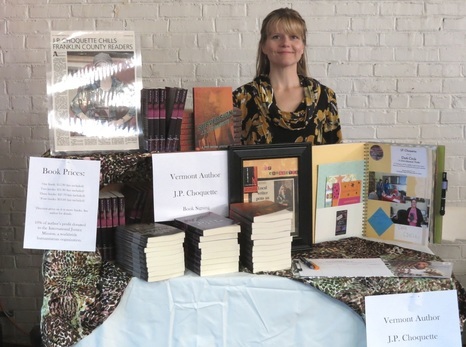How Much do Indie Authors Make?
At a recent book show, I noticed a recurring theme as I chatted with shoppers: the majority seemed interested in "how much an author makes." One person went so far as to ask me how much income I bring in by selling books, another asked how many copies of
Dark Circle
I'd sold since it was published last year. (For the record? I don’t carry that kind of information around in my head. There’s barely enough room to manage my day-to-day in there.)
Honesty is important though, and even though some of the questions felt a little invasive, (do I ask my customers how much they make before selling them a book?!), I understand the curiosity. There is much ado in the papers and online about indie authors making a killing by writing and publishing their own books.
While I'm not going to share my Profit and Loss statement with the world just yet, I'm happy to tell you how much income is generated from book sales each month. First a little primer … How Indie book sales work
First, let’s look at how book sales work in the indie world. When you’re an indie author you get to keep a higher (in most cases, much higher) percentage of royalties than a traditionally published author. However, that comes at a price: you aren’t represented by a publishing house and have no agent, which means that no one, other than you, promotes your work.
Digital book sales
Generally, the royalty split on a site like Amazon are 70/30: the author keeps 70% and the distributor/store make 30%. This is true only for books priced over $2.99. So, for my book Subversion, priced at $3.99, I make approximately $2.80 per book sale. Epidemic, which has been my best seller this year, is priced at $5.49, however Amazon runs a constant “sale price” of $3.99. I still collect royalties on the higher sale price.
Higher sale prices result in higher royalties for the author, but this must be weighed against how much readers are willing to spend, particularly on an unfamiliar-to-them author. ( Note : this is why book reviews/stars are so incredibly important to indie authors. It’s like a vote—positive or negative—for your book. Even a negative review is better than none, believe me!)
 At the Women's Festival of Crafts, November 2014 Paperback book sales
At the Women's Festival of Crafts, November 2014 Paperback book sales
Paperback sales are a little different: in general I receive 1/3 of the royalties on a paperback book that’s published through CreateSpace. This makes some sense: they are printing the books and distributing them for me. However, unless you’re Louise Penny, it’s likely that no one will find your book on Amazon or Barnes and Noble unless they search for it specifically.
The beauty of the paperback format though, is private sales. I can order as many books as I like and sell them at retail price. I take my boxes of shiny books to a show, enjoy a day chatting with book lovers, and hopefully make a bit of profit (after paying the show fee and for promotional items like my new bookmarks and postcards).
In general, I make $10 per book through private sales, after taxes (yes, you're required to collect taxes and send these in to the state tax agency). This is double what I make if Amazon or Barnes and Noble sell the book for me. Plus, I get to meet readers—that’s a great deal of fun.
“How much income are your books bringing in?”
It’s hard to give a concrete number because none of them are concrete! Sales vary. I should also note that I'm completely lackadaisical about marketing my books. I rarely run ads. I barely even take the time to let people know that there's a sale going on. So nearly all my sales now are just word of mouth or searching the bookstore sites.
Paperback sales online are typically slower, though I have had a recent spike due, I think, to some recent reviews/guest posts on various blogs.
Shows (and thus, private sales) vary greatly as well: at one show I recently sold 30 books, at another only five. Lots of indie authors have decided to sell only ebooks. This cuts down on production costs and energy. If you want a good overview of the range that indie authors are making, be sure to check out the Author Earnings by hall of fame indie author, Hugh Howey.
When all is said and done though, my book sales break down like this:
Private sales (includes in-person shows): 65%Digital sales (Amazon, Barnes and Noble, Smashwords): 25%Paperback sales (online): 10%
I hope this is helpful information. I’m happy to answer questions you have—just leave a comment or get in touch via email or Twitter.
Honesty is important though, and even though some of the questions felt a little invasive, (do I ask my customers how much they make before selling them a book?!), I understand the curiosity. There is much ado in the papers and online about indie authors making a killing by writing and publishing their own books.
While I'm not going to share my Profit and Loss statement with the world just yet, I'm happy to tell you how much income is generated from book sales each month. First a little primer … How Indie book sales work
First, let’s look at how book sales work in the indie world. When you’re an indie author you get to keep a higher (in most cases, much higher) percentage of royalties than a traditionally published author. However, that comes at a price: you aren’t represented by a publishing house and have no agent, which means that no one, other than you, promotes your work.
Digital book sales
Generally, the royalty split on a site like Amazon are 70/30: the author keeps 70% and the distributor/store make 30%. This is true only for books priced over $2.99. So, for my book Subversion, priced at $3.99, I make approximately $2.80 per book sale. Epidemic, which has been my best seller this year, is priced at $5.49, however Amazon runs a constant “sale price” of $3.99. I still collect royalties on the higher sale price.
Higher sale prices result in higher royalties for the author, but this must be weighed against how much readers are willing to spend, particularly on an unfamiliar-to-them author. ( Note : this is why book reviews/stars are so incredibly important to indie authors. It’s like a vote—positive or negative—for your book. Even a negative review is better than none, believe me!)
 At the Women's Festival of Crafts, November 2014 Paperback book sales
At the Women's Festival of Crafts, November 2014 Paperback book salesPaperback sales are a little different: in general I receive 1/3 of the royalties on a paperback book that’s published through CreateSpace. This makes some sense: they are printing the books and distributing them for me. However, unless you’re Louise Penny, it’s likely that no one will find your book on Amazon or Barnes and Noble unless they search for it specifically.
The beauty of the paperback format though, is private sales. I can order as many books as I like and sell them at retail price. I take my boxes of shiny books to a show, enjoy a day chatting with book lovers, and hopefully make a bit of profit (after paying the show fee and for promotional items like my new bookmarks and postcards).
In general, I make $10 per book through private sales, after taxes (yes, you're required to collect taxes and send these in to the state tax agency). This is double what I make if Amazon or Barnes and Noble sell the book for me. Plus, I get to meet readers—that’s a great deal of fun.
“How much income are your books bringing in?”
It’s hard to give a concrete number because none of them are concrete! Sales vary. I should also note that I'm completely lackadaisical about marketing my books. I rarely run ads. I barely even take the time to let people know that there's a sale going on. So nearly all my sales now are just word of mouth or searching the bookstore sites.
Paperback sales online are typically slower, though I have had a recent spike due, I think, to some recent reviews/guest posts on various blogs.
Shows (and thus, private sales) vary greatly as well: at one show I recently sold 30 books, at another only five. Lots of indie authors have decided to sell only ebooks. This cuts down on production costs and energy. If you want a good overview of the range that indie authors are making, be sure to check out the Author Earnings by hall of fame indie author, Hugh Howey.
When all is said and done though, my book sales break down like this:
Private sales (includes in-person shows): 65%Digital sales (Amazon, Barnes and Noble, Smashwords): 25%Paperback sales (online): 10%
I hope this is helpful information. I’m happy to answer questions you have—just leave a comment or get in touch via email or Twitter.
Published on August 06, 2015 11:30
No comments have been added yet.



